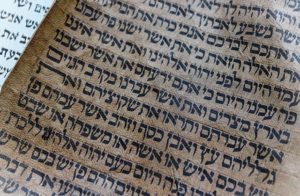As far as basics in life goes, the alphabet ranks pretty high. We start learning it usually before we reach school, sometimes even before our memories have fully formed. It is the foundation of literacy which, in our Age of Information, is pretty important.
Yet in ancient times, writing—and being able to read what was written—was a skill that belonged primarily to priests. Add in the fact that inscriptions were engraved on tombs of the dead, and it’s not hard to believe that writing was viewed as a hidden wisdom with a connection to the underworld.
Secrets
The word “rune” comes from the Germanic root word run-, meaning “secret” or “whisper.” Runes were carved inside tombs to protect the dead, either from evil forces or from vandals, or perhaps to keep the dead themselves from rising. Odin hung on the world tree Yggdrasil for nine days and nights to gain mastery over the runes. And that seems to be a recurrent theme when looking at the history of various alphabets—that they were brought to man by the gods themselves.
The Egyptians called their form of picture-writing “the speech of the gods.” The Greeks called it hieroglyphics, or “sacred carvings.” Because this form of writing came from the gods, and because they were comprised of pictures, it was believed that a picture of something not only symbolized what it depicted, it literally was the thing drawn. So, if an animal was drawn inside a tomb as part of an inscription, it was feared that the animal would come alive and eat the food provided for the deceased—or even the dead man himself. The solution was to leave the hieroglyph incomplete, or drawn in two halves, so that the animal could not take form.
Words of creation
 Perhaps the most notable link between divine forces and an alphabet is Hebrew. The Hebrew alphabet has 22 letters, all of which are consonants. (Whenever I try to imagine writing with no vowels, my head starts to hurt. But I digress.) The importance of the Hebrew alphabet is that God is described in the Bible as speaking the world into existence. “Let there be light,” and all that. And the language God spoke, of course, was Hebrew. So, the Hebrew alphabet came to be regarded as highly magical, as it was essentially the building-blocks of creation. From here, it’s a veritable rabbit hole of mysticism where the Hebrew letters are split into categories that correspond with, among other things, seasons, elements, zodiac symbols, months of the year, organs of the body, the planets known in antiquity, directions (north, south, etc.) and perceptions such as sight and smell. Knowing which letters corresponded with different aspects of the universe, gave one power over that part of the universe.
Perhaps the most notable link between divine forces and an alphabet is Hebrew. The Hebrew alphabet has 22 letters, all of which are consonants. (Whenever I try to imagine writing with no vowels, my head starts to hurt. But I digress.) The importance of the Hebrew alphabet is that God is described in the Bible as speaking the world into existence. “Let there be light,” and all that. And the language God spoke, of course, was Hebrew. So, the Hebrew alphabet came to be regarded as highly magical, as it was essentially the building-blocks of creation. From here, it’s a veritable rabbit hole of mysticism where the Hebrew letters are split into categories that correspond with, among other things, seasons, elements, zodiac symbols, months of the year, organs of the body, the planets known in antiquity, directions (north, south, etc.) and perceptions such as sight and smell. Knowing which letters corresponded with different aspects of the universe, gave one power over that part of the universe.
And if you could use letters from more than one alphabet, then all the better. Alchemists were rather fond of using the word “Azoth” for mercury (based on the Arabic word “al zauq” for the metal) as it combined the first and last letters of the Hebrew, Greek, Roman, and Arabic alphabets, making it particularly potent in magic.
Assigning numbers to the different letters of the alphabet results in numerology—the belief that one’s essential truth can be ascertained based on one’s name. Napoleon is apparently the poster-child of numerology because, as the story goes, when he spelled his name Buonaparte, his number was 1—which represents power and victory. When he dropped the U from his name, spelling it Bonaparte, his number was changed to 4, which represents defeat. *cue ominous music*
One of man’s best inventions
Stripping all that down, though, and going back to the root of where our alphabet came from, takes us to about 1100 BC to when the Phoenicians refined the Canaanite alphabet into the Phoenician alphabet. Like Hebrew, it consisted of 22 consonant letters and no vowels. Given the limited amount of letters, and the fact that these letters could be used to write words in many different languages phonetically, it was favored by traders. It made its way to Greece, where the Greeks must have also gotten headaches and added vowels to that shit. A version of this alphabet eventually made its way to Rome–by way of the Etruscans I believe, who added their own alterations to it, as did the Romans once they got their hands on it. Thus providing us with the Latin alphabet that’s still widely used today. And, like the Phoenician alphabet from so long ago, it’s used to write many different languages, even ones that do not use an alphabet at all, like Chinese.
And I find this history very remarkable. It feels like the best kind of human ingenuity. An idea that’s spread across the globe, each culture making adjustments to it, refining it for their own needs. For us, it is something that has always existed, and I wonder if that’s how early man also experienced it all those thousands of years ago, as this new form of writing reached their shores. Perhaps scribes once knew that it was an inherited gift, but I doubt they understood its origins, and so I can understand linking it with the divine. For man to create something so irreplaceable, and so integral to the evolution of civilization that to imagine a world without it unthinkable is, perhaps, the most remarkable thing of all.
Source: Man, Myth, & Magic: An Illustrated Encyclopedia of the Supernatural, Vol. 1, Marshall Cavendish Corporation, 1970


Hi Sara – I love the way words have been created over the centuries and eras … and how easy we have it today – the word spread across the globe … thanks for this overview of the alphabet – cheers Hilary
We have it so easy that we don’t even think about it, really. Thanks for stopping by, Hilary!
It’s good to see another post from you. This is really interesting. I had realized that writing like anything changes over the years, and that the modern alphabet is greatly influenced by the Romans, but there is a lot more to it than I realized.
Thanks, Michelle. Yeah, there was more than I realized as well. Pretty interesting stuff, really. 🙂